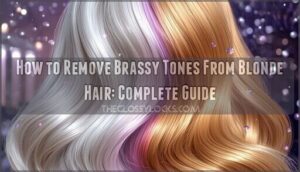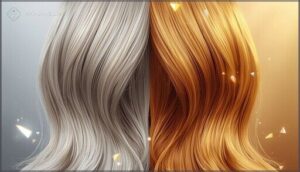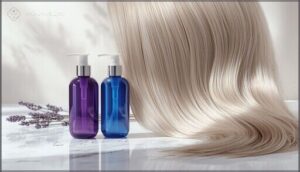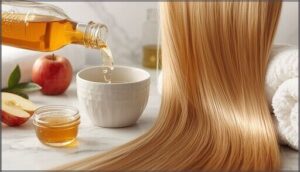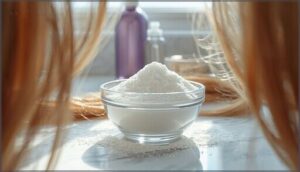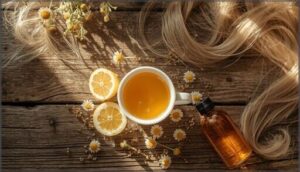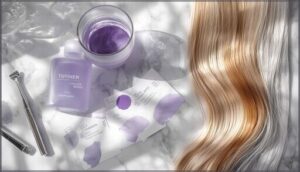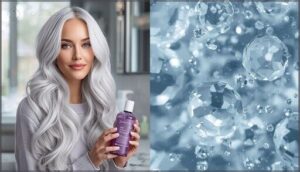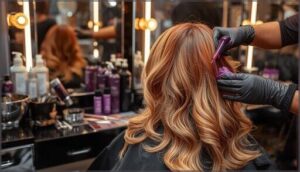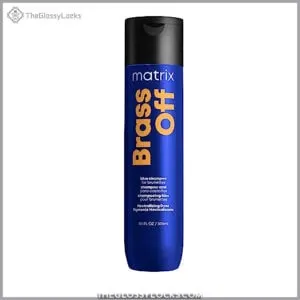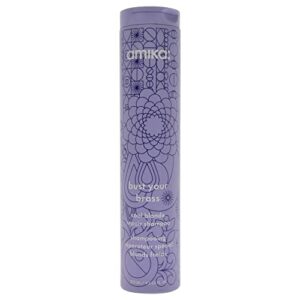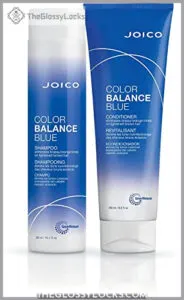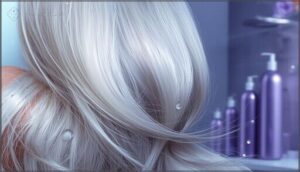This site is supported by our readers. We may earn a commission, at no cost to you, if you purchase through links.
You finish your salon appointment with the perfect cool-toned blonde—only to watch it morph into brassy yellow within weeks. That unwelcome warmth isn’t a sign of poor technique; it’s the natural consequence of how bleached hair interacts with minerals, oxidation, and environmental exposure.
Once you understand why blonde hair develops these orange and yellow tones, you can actively combat them using targeted purple shampoos, professional toners, and strategic color correction methods. The key lies in neutralizing unwanted pigment while protecting your hair’s integrity—a balance that requires both immediate intervention and ongoing maintenance. Reclaiming your cool blonde means taking control of the chemistry working against you.
Table Of Contents
- Key Takeaways
- What Causes Brassy Tones in Blonde Hair
- Identifying Brassy Tones in Your Hair
- Step-by-Step At-Home Solutions for Brassiness
- Choosing The Right Toner for Brassy Hair
- Preventing Brassy Tones in Blonde Hair
- Professional Treatments for Severe Brassiness
- Top 3 Products to Remove Brassy Tones
- Maintaining Bright, Brass-Free Blonde Hair
- Frequently Asked Questions (FAQs)
- Conclusion
Key Takeaways
- Brassiness develops when bleached hair reacts with hard water minerals, chlorine, UV exposure, and oxidation, turning cool blonde into unwanted yellow or orange tones that require active color correction.
- Purple shampoo neutralizes yellow brassiness while blue shampoo tackles orange tones—use them 1-2 times weekly based on your specific warm undertones, and always follow with deep conditioning to prevent dryness.
- Installing a shower filter to remove calcium and magnesium from hard water prevents mineral buildup that accelerates brassiness, making it more effective than relying solely on toning products.
- Professional salon toning every 4-6 weeks combined with at-home maintenance (filtered water, heat styling limits under 300°F, and strategic purple shampoo use) keeps your blonde cool-toned without constant damage from reactive color correction.
What Causes Brassy Tones in Blonde Hair
You didn’t sign up for orange or yellow tones when you went blonde, but brassiness has a way of showing up uninvited. Understanding what’s behind those unwanted warm tones puts you back in control of your color.
Let’s break down the main culprits so you can stop brassiness before it starts.
Effects of Hair Coloring and Bleaching
The thrill of transformation comes at a cost. When you bleach or color your blonde hair, you’re triggering chemical reactions that strip natural pigments and disrupt keratin bonds, leaving behind unwanted warm tones. Here’s what actually happens:
- Hair damage from oxidative agents weakens fiber strength and integrity
- Bleach risks include cuticle loss and increased cortical porosity
- Color fading accelerates as compromised strands lose moisture retention
- Follicle health can suffer from scalp irritation and inflammation
Understanding the chemical changes process is vital for maintaining healthy hair. Your hair toner becomes essential for color correction when structural changes reveal persistent brassy hair underneath.
Environmental and Water Factors
Beyond the salon chair, your environment wages constant war on your color. Hard water dumps calcium and magnesium onto every strand, creating mineral buildup that shifts blonde toward orange. Chlorine damage from pools binds copper ions to porous hair, while UV rays oxidize pigments into brassy chaos. Water pollution accelerates fading.
Hard water, chlorine, and UV rays relentlessly attack your blonde, depositing minerals and oxidizing pigments into unwanted brassy chaos
Install a shower filter to restore pH balance and reclaim control—your blonde depends on it. Understanding the effects of hard water issues is essential for maintaining healthy and vibrant hair.
Identifying Brassy Tones in Your Hair
Before you can tackle brassiness, you need to know what you’re actually looking at. Not all unwanted warmth is the same—your hair might be throwing yellow, orange, or even red tones depending on your base color and what’s gone wrong.
Here’s how to spot the culprit and decode what those brassy shades are really telling you.
Common Signs of Brassiness
Brassy tones don’t sneak up overnight—they announce themselves loud and clear. When your once-cool blonde starts staging a rebellion, you’ll notice these telltale brassiness symptoms:
- Unwanted warm tone issues appear as yellow, orange, or gold streaks that clash with your intended shade
- Color fading leaves hair looking dull and less vibrant than your original salon result
- Increased hair porosity creates a straw-like texture that’s harder to manage
- Dryness causes reduced shine, making brassy tones even more obvious
Recognizing these signs early puts you back in control of your hair color correction journey.
Differences Between Yellow, Orange, and Red Tones
Now, let’s break down what you’re actually seeing in the mirror. Yellow brass looks pale and smoky—think banana or nicotine stains—while orange brass shows up as copper or bronze, especially in highlighted brown hair. Red brass? That’s your rusty, auburn undertone, fighting for attention.
Color Theory and Pigment Analysis make Tone Correction and Warmth Management a targeted strategy, not guesswork.
Step-by-Step At-Home Solutions for Brassiness
Ready to kick brass to the curb without a salon appointment? There are practical ways you can tackle unwanted warm tones right at home.
Here’s how you can start reclaiming your blonde with a few tried-and-true solutions.
Using Purple and Blue Shampoos
Ever wonder why your blonde shifts from cool to brassy overnight? Purple Shampoo Benefits and Blue Toner Effects are your arsenal for Color Neutralization. Here’s how to wield them:
- Use Purple Shampoo 1–2 times weekly for yellow brass.
- Reach for Blue Shampoo to mute orange tones.
- Limit Toning Frequency to prevent pigment overload and dullness.
Apple Cider Vinegar Hair Mask
Think of Apple Cider Vinegar as your secret weapon for brassy hair—an Acidic Rinse Benefit that smooths the hair cuticle and restores Scalp pH Balance.
Mix a gentle Vinegar Dilution (about 0.5 tablespoon in 8 ounces water), apply as a Hair Mask, then rinse.
You’ll notice improved Color Enhancement and shine, making it a bold Natural Hair Remedy—not a Hair Toner, but a real breakthrough.
Baking Soda Hair Treatment
Rebellion against brassiness sometimes leads you to Baking Soda, but beware—its high pH throws your Hair pH Balance off-kilter and invites Cuticle Damage. The Abrasive Effects strip away buildup, yet also risk Scalp Irritation and dryness. If you’re set on trying natural hair remedies for brassiness, limit use and always follow with a restorative Hair Toner.
- Baking Soda Risks: dryness, breakage, irritation
- Disrupts Hair pH Balance and weakens cuticle
- Not a true Hair Toner—use sparingly for Brassy Hair
Homemade Blue Toner
Think of homemade blue toner as your secret weapon for color correction—a dash of blue food coloring in conditioner or diluted vinegar targets orange brassy hair without harsh chemicals.
These toner recipes lean on natural ingredients, offering a gentler alternative to purple shampoo. Still, mind your pH balance and Blue Dye Safety; always strand-test to avoid patchy results with this natural hair remedy for brassiness.
Tea and Lemon Hair Remedies
Looking for a rebellious fix that sidesteps harsh chemicals? Tea Rinses and Lemon Juice might tempt you—but don’t expect miracles. While Herbal Remedies and DIY Treatments like chamomile tea or lemon juice can brighten or slightly deepen tone, they won’t neutralize stubborn Brassy Hair. For best results, follow this order:
- Strand test
- Apply
- Rinse
- Condition
- Repeat cautiously
Choosing The Right Toner for Brassy Hair
Picking the right toner is your ticket out of the brass trap. Each option works differently depending on your hair’s needs and the tones you want to erase. Here’s what you should know before you get started.
How Toners Work to Neutralize Brassiness
Toners work through color correction chemistry—depositing complementary pigments directly into your hair shaft to cancel out unwanted warmth.
When you apply a violet or blue toner, those cool molecules penetrate the cuticle and neutralize brassy tones by counteracting yellow and orange reflections.
This pigment deposition process gives you control over your blonde, transforming chaotic warmth into the crisp, balanced color you’re after through precise neutralization techniques.
Selecting Toner Based on Brassy Shade
Your brassy shade dictates your toner color matching strategy. Use this shade selection guide for precision brass neutralization:
- Yellow brassiness (pale blonde): Deploy purple shampoo or violet toners for direct color correction
- Orange warmth (darker blonde): Grab blue-based toners to crush copper undertones
- Red-tinged brass: Apply green correctors to neutralize mahogany tones
Match your visible warmth to the opposite color wheel position—that’s how toning techniques deliver brass-free results you control.
Mixing and Applying Toner Correctly
Once you’ve picked your shade, nail the developer ratios: blend toner at 1:2 with 10-volume developer for deposit-only color correction.
Work in sections from back to front using a tint brush—this keeps application techniques precise and prevents patchiness.
Watch processing times carefully, usually 5 to 20 minutes depending on porosity. Cooler water rinses after seal your color depositing work and lock in that brass-free victory.
Preventing Brassy Tones in Blonde Hair
Prevention is your best defense against brassiness—it’s easier to stop warm tones before they start than to fix them later.
Your daily habits and the water you use make a bigger difference than you might think.
Let’s break down the three key strategies that’ll keep your blonde looking fresh and cool-toned between salon visits.
Washing Hair With Filtered or Soft Water
Beyond purple shampoo, your tap water might be sabotaging your blonde. Hard water dumps minerals onto your hair shaft, accelerating brassiness and fade. Take control with these filtered shower strategies:
- Install a showerhead filter to strip calcium, magnesium, and iron before they touch your strands
- Switch to soft water benefits—clearer tones, longer-lasting color, less buildup
- Use clarifying treatments monthly for mineral removal in hard-water zones
- Rinse with filtered water after pools to prevent chlorine-metal reactions
Water filtration transforms your entire hair care routine for colored hair, protecting porosity and maintaining color protection without extra products.
Limiting Sun and Chlorine Exposure
Sunlight and pool chemicals wage war on your blonde—UV breaks down pigment while chlorine opens your cuticle for copper invasion. Fight back with UV protection tips like SPF hair mists and wide-brim hats.
Before swimming, wet your hair with clean water to block chlorine absorption, then use chelating shampoos for chlorine removal methods.
Layer sunscreen for hair into your color maintenance routine alongside pool water damage defenses—your brightness depends on it.
Regular Hair Conditioning and Hydration
Weekly Deep Conditioning sessions actively lock down your color molecules—hydrated hair clings to pigment while porous, dry strands bleed it out fast. Balance your Moisture Balance to flip the script on fading:
- Apply coconut oil pre-wash to seal cuticles and block dye migration
- Target mid-lengths to ends with intensive treatments for Color Retention
- Increase frequency after bleaching, then taper as Hair Damage Repair progresses
- Choose silicone-enriched formulas that reduce Hair Porosity and prevent wash-out
Master Hair Hydration, own your tone.
Professional Treatments for Severe Brassiness
Sometimes at-home fixes just won’t cut it, especially when you’re dealing with stubborn orange or copper tones that refuse to budge. That’s when it’s time to hand the reins over to a professional who can assess your hair’s history and customize a treatment plan.
Here’s what salons offer when brassiness gets out of control.
Salon Color Correction Services
When your blonde has crossed into uncharted brassy territory, salon color correction services become your strategic rescue. Expect to invest 350 to 700 dollars and three to six hours for thorough correction techniques that combine targeted hair toning and color depositing with balayage or highlights.
Professional consultations assess your hair’s history and create phased color correcting plans, addressing severe brassiness through multi-stage hair repair services that rebuild integrity while neutralizing warmth.
Customized Professional Toners
Professional salons deploy AI-based hair diagnostics to analyze your hair’s porosity and undertones, then blend demi-permanent toner formulations—mixing pearl, sand, or silver shades with clear diluters—to neutralize your specific brassiness.
These tailored professional toners apply color correction techniques with low-volume developers, targeting yellow or orange hues while preserving lightness.
Salon services command premium pricing because stylists tailor toning techniques to your exact hair profile, delivering precision home kits can’t match.
Pre-Shampoo Mineral Removers
Hard water dumps calcium and magnesium onto your hair shaft, turning your blonde muddy and dull—that’s where chelating agents like disodium EDTA become non-negotiable. Pre-shampoo mineral removers strip product buildup and metal deposits before you even lather up, restoring pH balance and hair health in minutes.
Apply these formulas to dry hair weekly if you’re battling hard water or chlorine exposure, especially after installing a showerhead filter for water filtration.
Pair with apple cider vinegar rinses between treatments to optimize hair clarifying and maintain your brightest blonde.
Top 3 Products to Remove Brassy Tones
You’ve learned the techniques, now let’s talk about the tools that’ll get you there. The right products don’t just mask brassiness—they neutralize it at the source and keep your blonde looking sharp between salon visits.
Here are three battle-tested options that actually deliver results.
1. Blue Shampoo For Brassy Hair
Orange undertones turning your blonde rebellion into a coppery mess? Blue shampoo deposits blue pigment that directly neutralizes those unwanted warm tones through color correction. Unlike purple shampoo—which targets yellow—blue formulas tackle orange brassiness head-on, especially in highlighted or balayage hair.
Your toning frequency matters: use it once weekly for maintenance, twice if brassiness is aggressive. Hair porosity affects results, so porous strands grab pigment faster. Pair blue shampoo with deep conditioner since shampoo ingredients can dry out color-treated hair. It’s your between-salon weapon for hair toning control.
Best For: Color-treated brunettes, dark blondes, and anyone with highlighted or balayage hair fighting orange or coppery brassiness between salon visits.
- Neutralizes orange and red tones in one wash by depositing blue pigments that sit opposite warm tones on the color wheel
- Works as affordable maintenance to extend professional color services, reducing how often you need salon toning appointments
- Delivers visible results quickly when used correctly, typically keeping brassiness at bay for 2–3 regular washes
- Can dry out hair with frequent use since the clarifying formula strips natural oils along with brassiness
- Overuse or leaving it on too long risks an ashy, blue-tinted cast or uneven patchy toning on porous hair
- Stains hands and skin easily during application, so you’ll need gloves to avoid temporary blue fingers
2. Cool Blonde Toning Shampoo Product
You want total command over yellow brassiness? Cool blonde toning shampoo, armed with purple pigment, is your sulfate-free warrior for strategic hair toning between salon appointments. These specialized toners deposit violet molecules that neutralize yellow through color correction. Apply once or twice weekly for blonde maintenance, leaving it on 3–5 minutes depending on brassiness intensity.
Unlike standard purple shampoo formulas, concentrated cool blonde versions deliver faster, more visible tone shifts. Pair toning shampoo with hydrating treatments since bleached strands need moisture reinforcement while you’re waging war on brassy hair.
Best For: Blondes, silver, or gray hair dealing with yellow brassiness who want to maintain cool tones between salon visits without over-drying their hair.
- Noticeably neutralizes yellow and brassy tones in just one to three uses, keeping blonde looking fresh and ash-toned longer
- Works for all types of blonde hair—natural, highlighted, balayage, or fully bleached—and gentle enough for weekly maintenance
- Sulfate-free formula with added proteins helps strengthen and hydrate damaged, color-treated hair while toning
- Can create a dull, gray, or lavender cast if you leave it on too long or use it too often, especially on porous hair
- May be too drying without a good conditioning treatment, and it can stain your shower if you’re not careful
- Not a daily shampoo—overuse can make hair look darker or feel oilier, and it doesn’t mix well with some other products
3. Color Balance Hair Care Set
When brassy hair demands full-system color correction, Joico’s Color Balance set delivers purple shampoo paired with conditioner for coordinated brass reduction. This 10.1-ounce duo neutralizes yellow through violet pigment deposition while preserving up to 89% of your hair color across 18 washes.
The Bio-Advanced Peptide Complex repairs damage from the inside out during hair toning, and SmartRelease Technology continuously feeds your strands keratin between color preservation sessions.
You’re getting salon-grade color balance without the appointment—just strategic maintenance that keeps brassiness locked down.
Best For: Blonde, highlighted, or gray hair that’s fighting yellow or brassy tones and needs both cleansing and conditioning in one coordinated system.
- Delivers visible brass neutralization in a single wash while maintaining color vibrancy for up to 18 washes
- Repairs chemically treated hair from within using peptides and keratin, so you’re correcting tone and damage simultaneously
- Sulfate-free formula won’t strip color, and the dual shampoo-conditioner approach means you’re covered from start to finish
- Can cause dryness on bleach-damaged hair, and the conditioner may not provide enough moisture for very dry types
- Stains hands, clothing, and surfaces easily—you’ll need gloves and careful rinsing
- Only works on blonde or gray hair; brunettes with orange tones need the blue version instead
Maintaining Bright, Brass-Free Blonde Hair
You’ve battled the brass and won—but keeping that cool, bright blonde takes more than a one-time fix. The real victory comes from building habits that protect your color from fading back into those unwanted warm tones.
Here’s how to lock in your results and stay in control of your blonde.
Establishing a Color-Protective Routine
Consistency becomes your greatest weapon against brass when you build a strategic Hair Care Routine around Color Protection. Start by rotating color-safe shampoos with purple formulas 1-2 times weekly, alternating with deep conditioning every seven days to lock in moisture. This Product Rotation approach maintains vibrancy in Color Treated Hair while preventing fade through careful Routine Scheduling.
| Routine Element | Frequency |
|---|---|
| Purple shampoo | 1-2x weekly |
| Color-safe wash | 2-3x weekly |
| Deep conditioning | Weekly |
| Toning treatment | Every 3-4 weeks |
| Professional refresh | Every 4-6 weeks |
Proper Hair Maintenance protects your investment through disciplined Color Maintenance and strategic Damage Prevention practices.
Reducing Frequency of Heat Styling
Your flat iron habit might be sabotaging your cool tones faster than you think. Thermal Protection becomes non-negotiable when preserving Color Preservation in lightened strands—research shows styling more than three times weekly accelerates Hair Porosity and oxidation, turning ash blonde brassy within weeks.
Set firm Heat Styling Limits at 300°F maximum, embrace air-drying most days, and watch your color stay true longer while supporting Hair Damage Repair and Protection through smarter Styling Frequency choices in your Hair Maintenance Routines.
Scheduling Regular Toning and Maintenance
Smart salons book color-treated hair toner refreshes every 4–6 weeks—that’s your Maintenance Schedules sweet spot for Toner Longevity and Color Protection.
Between appointments, lean on purple shampoo 1–2 times weekly to hold those cool tones.
This Hair Regimen rhythm keeps brass at bay and sidesteps emergency color correcting sessions, giving you consistent color maintenance without constant damage from reactive hair color correction work.
Frequently Asked Questions (FAQs)
How often should I tone my blonde hair?
Want to keep your blonde shade fresh without overdoing it? You’ll usually need professional toner every four to eight weeks, depending on your hair porosity and how quickly your color fades.
Do hair vitamins help prevent brassy tones?
Hair supplements won’t prevent brassy tones—brassiness stems from oxidation and mineral buildup, not vitamin deficiencies.
While nutrients support overall hair health, managing brassy hair requires targeted color correction techniques and proper hair care and maintenance instead.
Can I swim after getting my hair toned?
You can swim 48 to 72 hours after toning, but waiting a full week protects freshly deposited pigments from chlorine damage.
Skip the pool too soon, and brassiness returns fast—undoing all that color correction work.
Does hair porosity affect how quickly brassiness develops?
Absolutely—high porosity hair develops brassiness 40% faster because open cuticles absorb minerals and oxidize quicker.
Bleaching triples porosity, letting iron deposits and UV damage trigger unwanted warm tones within just 5–10 washes.
Conclusion
Brassiness doesn’t stand a chance once you’ve mastered the color wheel and committed to consistent maintenance. Learning how to remove brassy tones from blonde hair transforms you from passive victim of oxidation to confident architect of your color.
Purple shampoo becomes your weekly ritual, toner your emergency reset, and filtered water your secret weapon.
Your blonde isn’t at the mercy of minerals and UV damage anymore—you’ve taken command of the chemistry, and that cool-toned ideal stays exactly where you want it.

